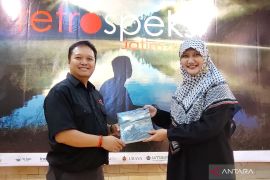London (ANTARA/Reuters) - Dutch scientists have found a way of turning plant matter into the building blocks of common plastics using a nanotechnology process that offers an alternative to oil-based production. The team from Utrecht University and Dow Chemical Co produced ethylene and propylene - precursors of materials found in everything from CDs to carrier bags and carpets - after developing a new kind of iron catalyst made of nanoparticles. Existing bioplastics, which are made from crops such as corn and sugar, have only limited use as they are not exact substitutes for oil-based products. The new system, by contrast, produces chemicals that are the same as those made in petrochemical works, allowing them to be used in a wide range of industries. This also means they will not be biodegradable, although they will be made from renewable resources. Researcher Krijn De Jong and his colleagues envisage using non-food sources of biomass for the new process, such as fast-growing trees or grasses, rather than traditional crops, in order to reduce competition for resources between food and fuel. Plastics made from biomass could, however, be vulnerable to the same criticism that has beset biofuel production. Critics say the production of some biofuels can occupy land that would otherwise be used for agricultural purposes, thus limiting food and water resources for a rapidly rising world population. Some biofuel production could also increase carbon emissions, especially if rainforests are cut down to facilitate production. The research by De Jong and his colleagues, which was published on Thursday in the journal Science, is still at an early stage. It now requires larger-scale testing and pilot projects, so it will not reach the market for several years. Rising Demand Diminishing reserves of fossil fuels and rising greenhouse gas emissions suggest there should be increased demand for bioplastics. But that argument could be disrupted by recent vast finds of shale gas, which now provide a cheap alternative feedstock for ethylene in the United States. The Dutch-designed catalysts consist of tiny nanoparticles separated from each other on carbon nanofibres. In laboratory tests, the catalysts proved highly effective at converting biomass-derived synthesis gas - a mix for hydrogen and carbon monoxide - in ethylene and propylene. Importantly, the process worked without producing large amounts of methane, an unwanted byproduct of another catalytic process using large iron particles. The team now plan to increase catalyst production by linking with experts from Johnson Matthey, the world's largest supplier of catalytic converters for vehicles. Nanotechnology, which involves designing and manufacturing materials on the scale of one-billionth of a metre, is a rapidly expanding area of materials science with applications in medicine, electronics and coatings.(*)
Berita Terkait

Dewas ANTARA harap kinerja Biro Jatim terus tumbuh
17 Desember 2025 19:30

ANTARA terima penghargaan peran penyebaran informasi Kumham Imipas
17 Desember 2025 13:59

Konjen RRT-ANTARA Jatim masifkan penyebaran informasi positif dua negara
16 Desember 2025 19:45

DPR nilai pemberitaan ANTARA masih menjadi tolok ukur
16 Desember 2025 19:02

Ketua Fraksi PKS DPRD Jatim: ANTARA miliki karakter yang berbeda
16 Desember 2025 18:16

Ketua Dewas ANTARA: Kantor berita bertanggung jawab tangkal hoaks
16 Desember 2025 18:00

Kadis Kominfo Jatim apresiasi peran ANTARA jaga kualitas informasi
16 Desember 2025 17:02


